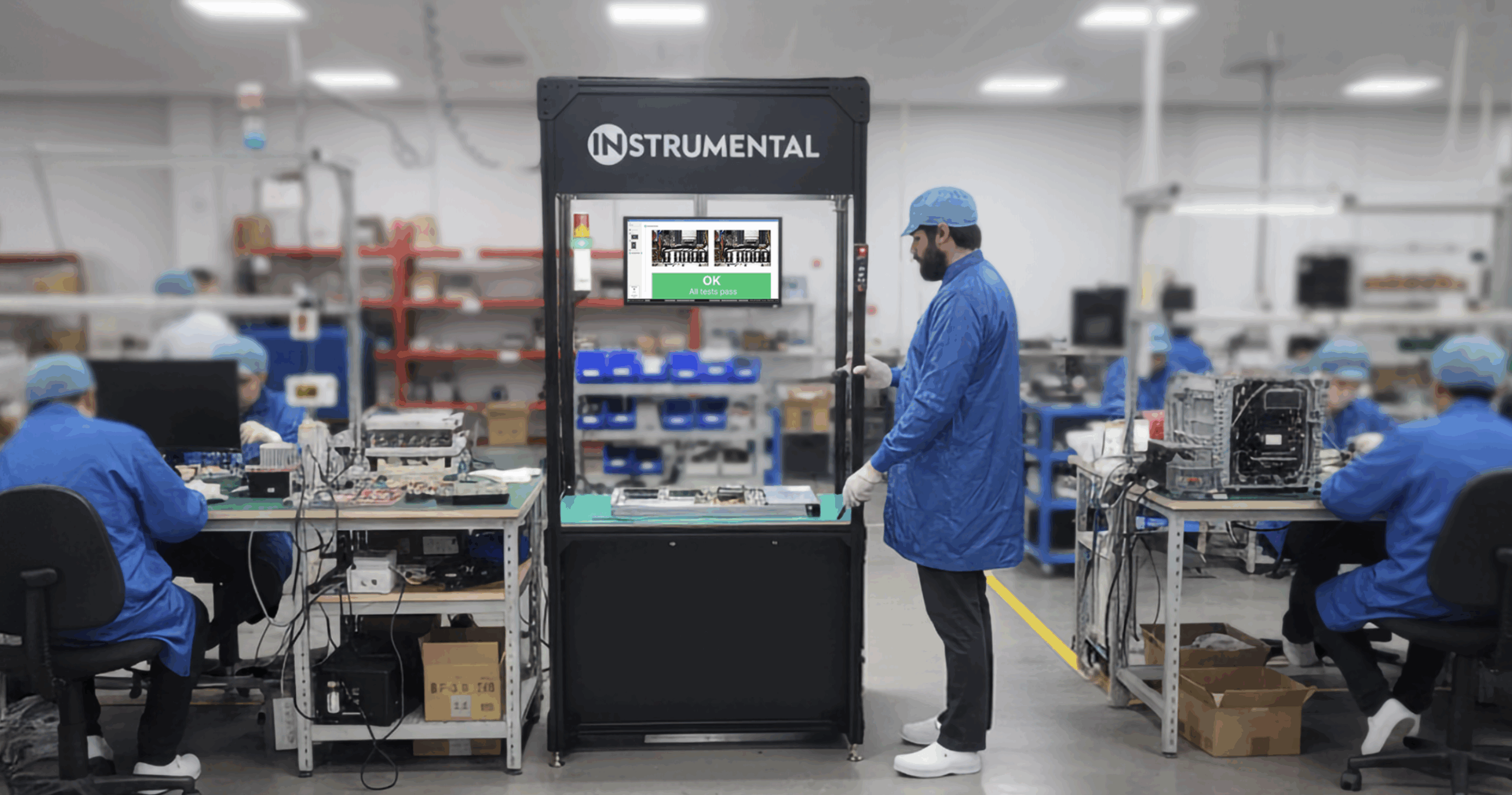The first boomboxes were introduced in the 70s unlocking the ability to share your music with friends outside. As we moved from cassette tapes to CDs to MP3 players, our portable audio products evolved too. Today, with our music streaming on our phones, the bluetooth speaker has become the latest incarnation. While products like the Beats Pill and the Aliph Jambox propelled them into the mainstream consciousness in the late 2000’s, new companies are continuously innovating and bringing us new and better ways to listen.
Though Sonos was founded in 2002, their recently released Roam product is the high-end audio company’s first truly portable speaker. Launched in 2021, it is compact with a rounded triangular prism form factor that you can pick up with one hand and easily toss in a backpack. Unlike previous Sonos speakers, it is waterproof with an IP67 rating and comes with both Wi-Fi and bluetooth connectivity. In this episode of Change Notice, we took a look inside to see how Sonos engineered the Roam to meet their exacting standards.
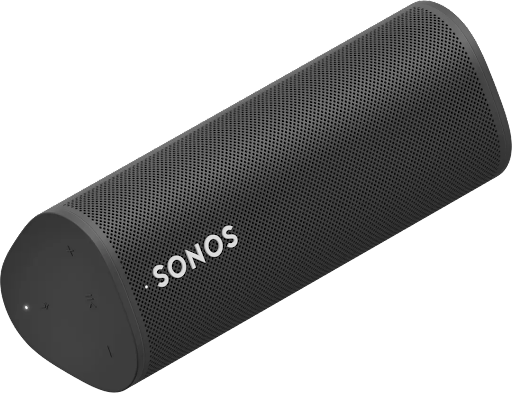
Sonos Roam courtesy of sonos.com
Joining Tobias and I in this teardown was special guest Ron Roberts, the lead product design engineer for the project. While we had no insider information about this product, Ron offered us the rare opportunity for us and our audience to ask questions about the challenges and complexity of the design as well as some stories of how the product came to be.
Tough Endcaps
To open up the Sonos Roam, which has no visible fasteners, I started by removing the TPU overmolded end caps. These parts were held down with a strong adhesive which was a bit difficult to remove. Ron shed some light on this by telling us that the Roam needed to pass a new suite of reliability tests they had created specifically for this product.
Unlike previous speakers, the Roam is much smaller and designed to be thrown in a bag or tossed around on the beach so they devised a rigorous new tumble test spec to simulate customer usage. Upon testing their initial prototypes, they found the end caps were falling off. To combat this, they dove deeply into adhesive properties and looked for ways to achieve stronger adhesion between the parts. This included adhesive selection but also secondary processes like cleaning with alcohol and plasma treatment. These processes increased the surface energy of the plastic materials enabling a much stronger bond, as I found out when trying to open it.
Under one end cap we found a wireless coil and under the other buttons and a circuit board revision date of August 2020. When we asked Ron about the development, he mentioned that the Roam was designed and developed almost entirely during the pandemic! I was fascinated to hear how he and the team made it work. With the new form factor, added complexity of the product, and new reliability tests to try out, Ron said they had to come up with new methods of validation without physically being able to travel. Incredibly, they were able to launch the product on schedule and have also since kept many of the protocols they were forced to enact.
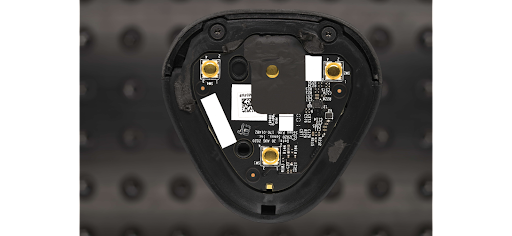
Underneath one endcap, remnants of the tape are still visible sticking to the Plasma Treatment activated surface of the main housing.
Inside the Main Speaker Chamber
With the end caps off, we next tackled the main speaker housing. I removed the front grill by removing the 4 screws hidden by the end caps uncovering the main speakers and a mysterious fabric port down the central axis. I then unscrewed the 6 remaining screws to reveal the internal architecture underneath. After unplugging the speaker connector, we were able to get a look inside. The front half of the module housed the two speakers, a tweeter and a subwoofer while the bottom half looked to house more of the electronics. This reminded us a lot of the architecture of the Sonos One we had taken apart in an earlier change notice. We returned to the images on the platform to zoom into some key areas.
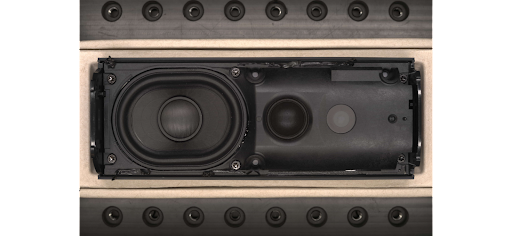
Sonos Roam with grill removed showing the woofer, tweeter, and a mysterious port.
Ron mentioned that Sonos develops its own transducers and pointed out that the woofer in the Roam is completely integrated into the housing. While it might be harder to replace, bonding the speaker into the plastic housing helped them save weight and space, reduce components, and enabled them to meet their water ingress rating of IP67.
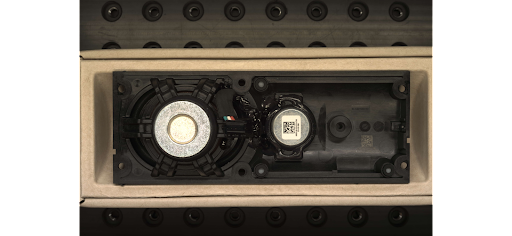
The Woofer is assembled to the plastic housing and permanently bonded.
We also learned that the mysterious port, instead of a microphone as Tobias and I had initially suspected, was actually a pressure equalization port. The engineering team needed a way to allow small amounts of air to enter the system while keeping water out especially when under different atmospheric pressures so they used a waterproof but breathable fabric similar to Gore-Tex used in a lot of winter clothing.
Speaker Electronics
As we moved through more of the hardware, we were struck by how much smaller the components were compared to the Sonos One. With the addition of Bluetooth, the electronics were actually more complex than their typical speakers which work primarily over Wi-Fi. Ron told us that the Sonos team needed to adopt more miniaturized technologies to fit everything together.
A few interesting elements stood out to Tobias and I with their electronics designs. One of their sets of Wi-Fi/Bluetooth antennas was actually made from soldered sheet metal parts instead of being on a Flex cable or etched into the board. Ron told us this was to put the two antennas on different planes which is easy to do with stamped parts.
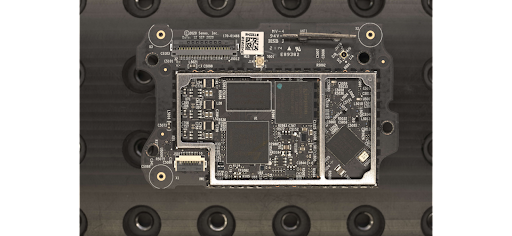
Main PCBA with the sheetmetal antenna sticking up at the top. Also the microphones are hidden underneath the board on 3 of the corners.
We also had a bit of trouble finding the actual microphones until we started to look a little closer. Because the Sonos Roam can work with both Google and Amazon voice assistants, they needed to incorporate multiple microphones which we eventually found in 3 locations on the back of the electronics board.
Finally, they chose to mount a USB-C connector onto their main power board in a peculiar way by soldering on a separate board. Ron told us that they did this specifically to address the ingress protection. They found a connector that worked, but it only came in the perpendicular orientation which forced them to create an interface board. But it all worked out in the end and because the USB-C connector served as one of the main locating features for the board sandwich, this actually worked out surprisingly well!
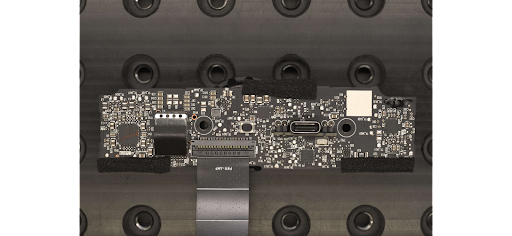
USB-C connector on a separate board which is then soldered back to the main power board
Product Designer Stories
While the Roam was not the most complex product we have ever taken apart, talking to Ron about his experience on the project was enlightening. Instead of speculating on different design decisions, we were able to pick his brain in person and get an idea of the different challenges he faced along the way and how they solved them. As a product design engineer, a lot of what we work on is not shared even though it often takes months if not years of work to release a new product. I wanted to thank Ron for being so open about the design of the Roam and hope we can hear more from him in the future! If you are able to share stories about products you have worked on and want to join and contribute to our growing community of Product Design Engineers, contact us at communications@instrumental.com.
Chris Li is a former Amazon Product Design Engineering Manager and teardown lead for Instrumental. He brought multiple generations of the Kindle to market and advised on the first Echo and Fire TV products. He also worked as the VP of Product Design at the healthtech startup, PillDrill, which shipped an award-winning medication tracking system. He is now a Mechanical Engineer at Agtonomy, an autonomous tractor startup.
Related Topics


